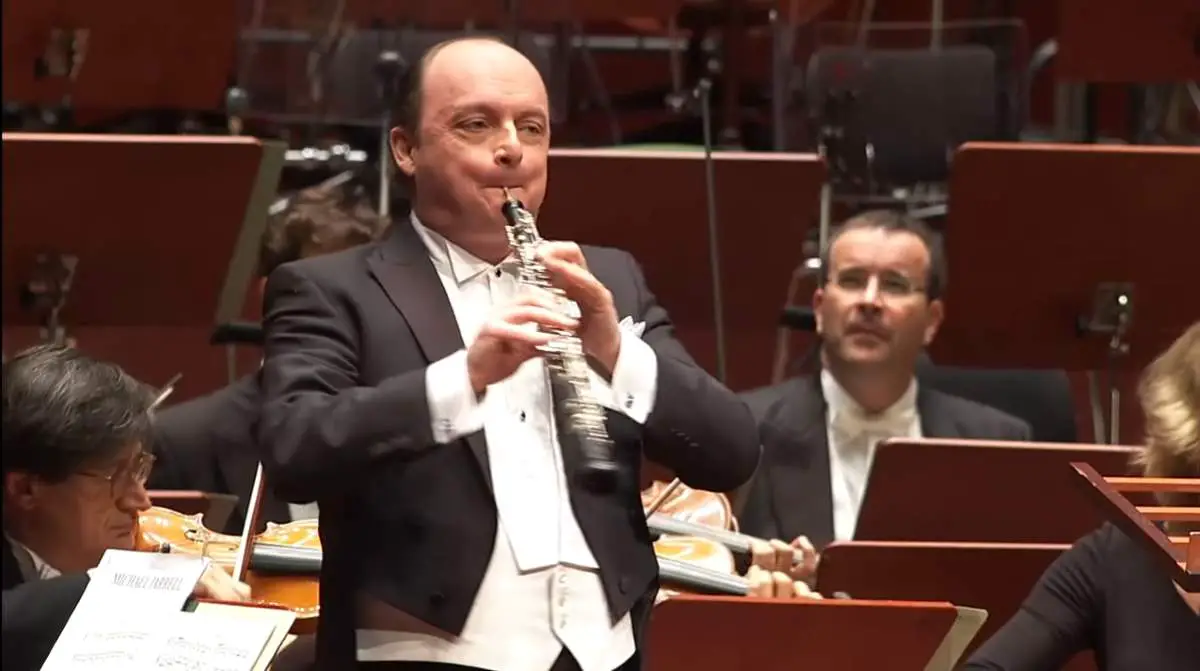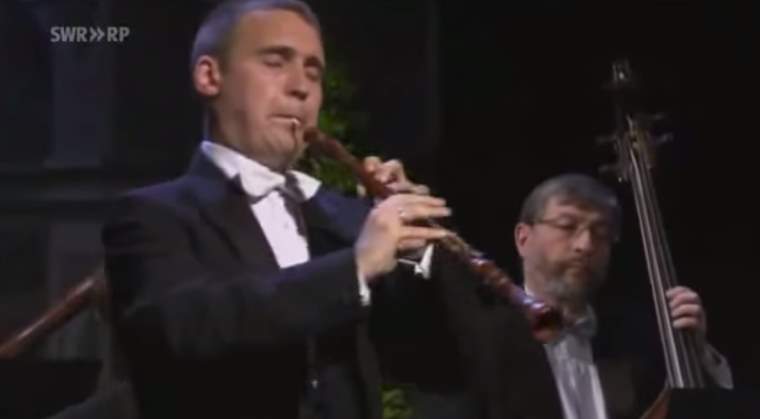Accompanied by the hr-Sinfonieorchester (Frankfurt Radio Symphony Orchestra), French oboist, conductor, and professor François Leleux performs Wolfgang Amadeus Mozart’s Oboe Concerto in C major, K. 314. Conductor: Andrés Orozco-Estrada. This performance was recorded at Alte Oper Frankfurt on October 14, 2016.
Mozart’s Oboe Concerto
Mozart’s Oboe Concerto in C major, K. 314, is one of the most significant works for the oboe, both for its technical demands and its lyrical beauty. Composed in 1777 for the oboist Giuseppe Ferlendis, the concerto highlights Mozart’s skill in writing for solo instruments. At a time when the oboe was gaining prominence in the orchestral and solo repertoire, this work became a defining piece for the instrument.
Mozart, always attuned to practical needs, later transposed the concerto for flute, creating the Flute Concerto in D major, K. 314, to fulfill a commission during his travels. This adaptation ensured that the music gained a broader audience, but the oboe version remained undiscovered for many years until its manuscript was unearthed in the 20th century.
The concerto is orchestrated for a string section with two oboes and two horns, typical of Mozart’s concertos. The work’s charm lies in its blend of virtuosic display and lyrical expressiveness, characteristics that make it a staple in both oboe and flute repertoires. The concerto follows the traditional three-movement structure, with a lively opening, a lyrical middle movement, and a spirited finale.
Movements
1. Allegro aperto
The first movement of Mozart’s Oboe Concerto opens with a vibrant orchestral introduction, laying out the cheerful and dynamic themes that set the tone for the soloist’s entrance. When the oboe enters, Mozart employs a clever trick by initially withholding the main theme from the soloist. Instead, the oboe starts with a brilliant ascending scale, ending on a high C, sustained for several measures – a gesture borrowed from operatic arias to immediately capture the audience’s attention.
The movement is filled with intricate passages and rapid runs, showcasing the oboist’s technical abilities while maintaining a light, playful character. The orchestra and soloist engage in a lively dialogue, alternating between thematic statements and virtuosic flourishes. After a brief development section, the movement features a cadenza, allowing the soloist to further display their virtuosity before the recapitulation leads to a jubilant conclusion.
2. Adagio non troppo
The second movement of Mozart’s Oboe Concerto is a poignant, lyrical interlude that contrasts beautifully with the lively outer movements. It is cast in the subdominant key of F major and takes on the character of a heartfelt aria. Mozart’s deep operatic experience shines through in this movement, with the oboe delivering an expressive, song-like melody over a delicate orchestral accompaniment.
The use of chromaticism enhances the emotional depth, giving the movement a reflective and almost melancholic quality. The oboe’s phrasing and dynamics are crucial here, as the movement demands a deep sensitivity to the shaping of each melodic line. The orchestral texture remains light, providing a gentle support that allows the oboe’s voice to soar. This movement exemplifies Mozart’s ability to evoke profound emotion within a relatively simple and elegant structure, leaving a lasting impression of serenity and introspection.
3. Rondo: Allegretto
The final movement of Mozart’s Oboe Concerto is a spirited rondo, characterized by a joyful and catchy main theme that serves as the anchor throughout the movement. This theme later found its way into Mozart’s opera Die Entführung aus dem Serail, underscoring its infectious charm. The rondo form allows for several contrasting episodes that showcase the oboe’s versatility.
These episodes vary in key and mood, providing both the soloist and the orchestra with opportunities to explore different textures and colors. The playful nature of the main theme is complemented by moments of lyrical introspection and virtuosic display, keeping the listener engaged. The movement’s lively tempo and rhythmic vitality ensure a jubilant and energetic conclusion, bringing the concerto to a satisfying and exuberant close. Throughout the movement, Mozart’s characteristic wit and elegance are evident, making it a delightful showcase for the soloist’s technical skill and musicality.
François Leleux
François Leleux (born July 1971 in Croix, Nord) is a French oboist, conductor, and professor. His professional career began at 18 when he became the principal oboe at the Paris Opera. He went on to win a solo position at the Bavarian Radio Symphony Orchestra and currently does some concerts with the Chamber Orchestra of Europe and puts out CDs. He is married to violinist Lisa Batiashvili.

Sources
- Oboe Concerto (Mozart) on Wikipedia
- François Leleux on Wikipedia
- Oboe Concerto in C major, K. 314/271k (Mozart, Wolfgang Amadeus) on theInternational Music Score Library Project website

